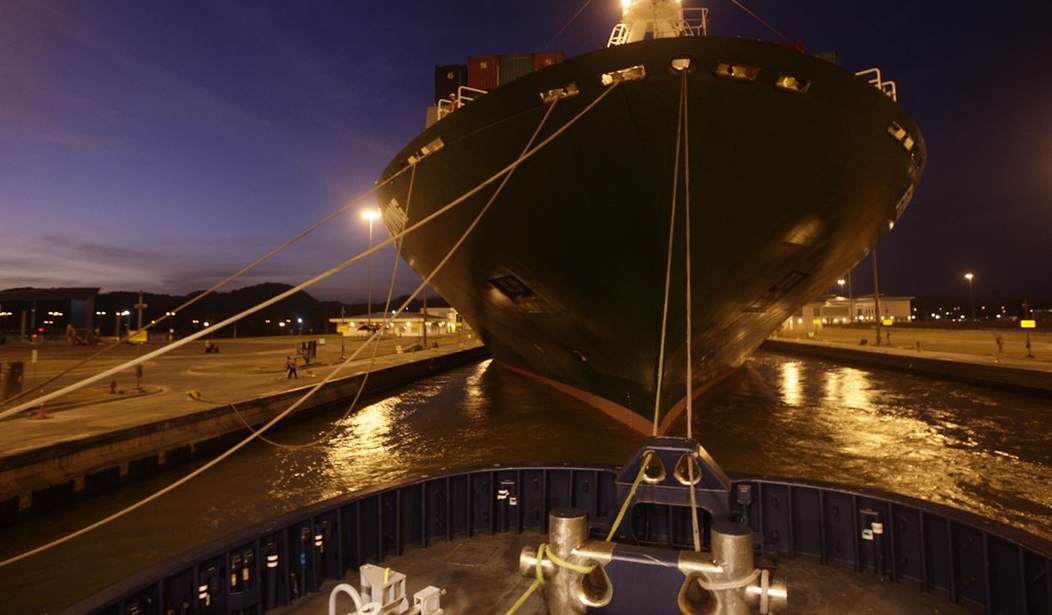It might be raining in California in August, but it’s the driest it’s been in Panama in about 100 years. And that is causing some serious problems at a place that never really registers in the national consciousness anymore – the Panama Canal.
And it really should, as 40% of our Asia to East Coast commercial traffic transits through the Canal Zone.
Low waters levels in the fresh water connection between the oceans on either side – Gatun Lake – have meant that the normal draft of 50 feet has been reduced to 44. In May, the Panamanian authority running the Canal Zone instituted travel restrictions trying to avoid vessels running aground in the shallower waters. Some container ships have even been forced to offload as much as a quarter of their cargo to make the transit. The last thing anyone wants is a repeat of a 2021 incident when a ship blocked the Suez Canal for 6 days and backed up over 400 other vessels.
Canal operations use three times the amount of water New York City uses every single day – is that not astonishing?
…The canal, which uses three times as much water as New York City each day, relies on rainfall to replenish it. If there isn’t enough rain, ship transits are cut and those that cross pay hefty premiums that boost transport costs for cargo owners such as American oil and gas exporters and Asian importers.
This is how the Panama Canal works 🚢 pic.twitter.com/69OYWksuWA
— Learn Something (@cooltechtipz) August 18, 2023
When water levels are low and replenishment depends on sparse rainfall, the Panama Canal Authority has to cut the number of crossings they allow…
…The number of daily transits through the canal has been capped at 32 by water authorities in a bid to conserve water.
…But the rainy season is yet to arrive in Panama and the canal is going through its driest spell in more than a century.
Restrictions for the number of vessels passing through has been extended until September 2.
…which causes its own set of problems. Vessels which want to transit have to pay a premium in addition to their passage fee to do so, if they want to make it into line for that day’s quota. And that premium can be major bucks. If they don’t get the jump on a spot, but are still desperate to cross, they can try their shot at an auction for one of them, and ho, boy – really fork over the cash.
…However some are caught up in the chaos and have to pay several times the average tolls.
Lars Oestergaard Nielsen, who is head of customer delivery in the Americas at shipping company A.P. Moller-Maersk, said: ‘We had two ships that couldn’t book and it was quite expensive.
‘We went to an auction and paid $900,000 on top of $400,000 normal toll fee for each ship to cross.’
Think what that’s doing to bottom lines for the merchandise or commodity the ships have onboard. What it’s doing on both the Atlantic and Pacific sides of the canal is backing shipping up something awful – darn near twenty days’ delay in many instances, as some ships have no fixed itinerary, or the products won’t bear paying a million dollar premium on top of the regular transit fee…so they wait for an open small boat slot.
In what is being called the “world’s worst traffic jam,” some 200 cargo ships are waiting to pass at the Panama Canal as the area experienced its worst drought in 100 years. pic.twitter.com/SHh6wa8muF
— Massimo (@Rainmaker1973) August 20, 2023
…’It’s risky to fix a ship with no firm itinerary because you can lose the contract if the wait is too long.
The Panama Canal is a big mess these days twenty days in a queue is unprecedented at this time of the year.’
Huge ships that move bulky items like coal and iron ore are stuck in the traffic jam. They are usually owned by medium or small operators and get no priority.
The restrictions could add more pressure on consumer goods prices, according to maritime firms and experts, as delays and extra fees add to shipping costs.
Spot shipping costs between China and the U.S. are already up 36% this year with the announcement of the restrictions.
So far the big container companies are adapting, having previously dealt with a similar situation in the 90’s.
…Referring to low water levels and the restrictions in place on the Panama Canal, Nielsen said the drought is prompting Maersk to load approximately 2,000 containers fewer than usual on the same vessel.
Typically, Nielsen said container ships might need to comply with a maximum depth of 50 feet on the Panama Canal. Current restrictions require ships to adhere to 44 feet of draft, forcing container ships to either weigh less or transport fewer goods.
“Six feet of water, that makes a big difference,” Nielsen said.
Panama has hired the US Army Corps of Engineers, who originally built the canal, about plans for diverting 4 other rivers to the canal zone in addition to the 3 that already feed Gatun Lake, setting aside $2B for the project. As it is, the Authority stands to lose $200M in revenue by year’s end if they don’t get some rain soon. It’ll really be a mess if the monsoon season isn’t a real drencher – and with an El Niño on the way – there are fears it won’t be.
…Water levels in Gatun Lake, the rainfall-fed principal reservoir that floats ships through the Panama Canal’s lock system, have remained below normal despite accumulation from the current rainy season.
A potential early start to Panama’s dry season and hotter-than-average temperatures typical of major El Nino events in the country could increase evaporation from Gatun Lake and result in near-record low water levels by March or April 2024, said STRI’s Steven Paton.
While I’m on the subject, every last one of the resources I linked is replete with climate cult argle-bargle and doom. What’s happening is that the Canal is going through it’s driest spell in”more than a century,” which means this has happened before but we’ll pretend it never has. And Reuters was banging the cult drum with what was noticably left out of this line:
…The area around the canal is experiencing one of the two driest years in the country’s 143 years of keeping records, data from the canal authority and the Smithsonian Tropical Research Institute (STRI) showed. Rainfall measurements around the area are 30-50% below normal.
I could probably guess that other “driest year” was, oh, about 100 years ago. So maybe we have 100 year cycle on our hands? One, this is rare, but not unprecedented. Two, it’s weather and as it has repeated itself in the record, not established one, maybe put the fire out in your hair and just report on the situation, eh?
Keep in mind these are the same people who are absolutely crushed they can’t tie yesterday’s Ojai earthquake to Tropical Storm Hilary. I mean, when even a geologist doesn’t have enough integrity to flat out squash the nonsense…
Dr. Lucy Jones was asked if there was any connection between Tropical Storm #Hilary and today's Ojai #earthquake.
"There is no particular relationship between the weather and what's happening underground," Jones said. https://t.co/lzqxT68UXC pic.twitter.com/s81X33eHB8
— ABC7 Eyewitness News (@ABC7) August 20, 2023
YGTBFKM
So. Pro-active is good. As one of the five major world waterways (Suez and Panama canals, the Strait of Malacca between Indonesia and Malaysia, the Strait of Hormuz between Iran and Oman, and the Bab-el-Mandeb between Djibouti and Yemen), at least they’re just fighting the weather.
No one will be yelling, “Low bridge, everybody down!” until they get a couple really good tropical downpours.







Join the conversation as a VIP Member